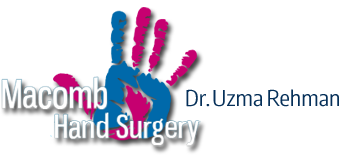Surgeons Explain What to Expect After Elbow Surgery
The elbow is a very complex piece of human machinery. The elbow is actually a hinged joint that is made up of three separate bones: the humerus, ulna, and radius. The bones in the elbow are held together by ligaments and the ends of the bones are covered with cartilage. Cartilage is a rubbery tissue that absorbs shock and allows the bones in the joint to slide easily when they are up against one another.
Because of the elbow’s complexity, many injuries to the elbow joint (including most elbow fractures) can only be repaired with surgery.
In this article Detroit area board certified hand surgeon Dr. Uzma Rehman explains what patients can typically expect after elbow surgery. Remember, this is general information only that may be useful after your elbow surgery – always follow the instructions provided to you by your surgeon when recovering from elbow surgery.
Pain Management After Elbow Surgery
Patients are given long-acting local anesthetic around the incision when undergoing elbow surgery. The numbing effect of this anesthetic can often last from six to eight hours, and sometimes as long as 12 hours. This anesthetic may also cause part of your arm and hand to feel numb after elbow surgery, as well.
As the local anesthetic wears off this numbness in the hand will subside and patients typically feel a tingling sensation in the fingers (similar to when your hand falls asleep after laying on it for a long period of time). Patients will then start to feel pain at and around the surgical site. This tends to happen very suddenly, so patients are advised to take their pain medication as soon as they feel the anesthetic begin to wear off, and regularly after that.
Remember, pain meds generally take between 30 to 60 minutes. So, do not wait until the pain is intolerable to take your prescribed pain medication.
Your surgeon may allow you to combine your pain medication with an anti-inflammatory medication like Advil, Aleve or Motrin. Generally, when combining prescription pain meds with Advil or Motrin, three 600 mg tablets are recommended three times a day. For patients using Aleve (naproxen) two 440 mg tablets are taken twice a day.
Make sure you have your surgeon’s approval before taking these medications and take them with food to avoid stomach upset.
Elbow Surgery After Care
It is normal for the arm to be quite stiff and sore for the first few days after elbow surgery. Patients can expect some swelling in the hand and fingers on the affected side, in addition to bruising in the forearm.
Try to keep the arm elevated as much as possible after arm surgery. And patients should begin moving the fingers the first day after surgery. Your surgeon will typically supply you with instructions for optimal hand and finger movements.
Apply ice to the area for the first 48 hours after elbow surgery. Remember, do not apply the ice directly to the skin – but make sure there is fabric between the ice and skin.
Splinting After Elbow Surgery
Most patients will have a splint placed on their arm after elbow surgery. A partial “sandwich cast” may be used. The skin is wrapped in a soft cotton layer with a strip of hard plaster on either side of the forearm and up the other. This type of splint allows swelling without damaging the skin or tissue around the surgery site. Do not get a plaster cast wet, as it will soften and stay wet, and this can delay the healing process.
A dynamic elbow splint called a “dynasplint” may also be used to apply gentle force that straightens or bends the elbow. The degree and amount of force can be progressively adjusted to the patient’s own tolerance.
Moving After Elbow Surgery
Begin to gently move your fingers as soon as you can after elbow surgery. Typically, surgeons suggest patients start by flexing and extending your fingers gently until all your motion has returned. Your motion should improve a little bit every day.
Once the incision has stopped oozing, patients can begin to get grip strength back by squeezing gently on a soft ball or sponge. Your surgeon will supply you with exercises you can begin doing once the bandage is removed. Always make sure to take your pain medication an hour before you start your exercises, as they can cause discomfort.
Detroit area hand surgeon Dr. Rehman has an outstanding staff of Certified Hand Therapists that will provide the highest standard in elbow rehabilitation to ensure the most rapid and complete recovery.
When to Contact Your Elbow Surgeon After Surgery
If you follow your surgeon’s aftercare instructions and attend your post-surgical appointments, complications of elbow surgery are rare. However, always contact Dr. Rehman or your hand surgeon if you experience any of the following post-surgery symptoms:
- Temperature over 101 Fahrenheit
- Persistent numbness in your hand
- Increasing, severe pain in the hand
- Increasing redness around the incisions
- Vomiting or prolonged itching, constipation or irritability from your pain medication
Top Detroit Area Elbow Surgeon
Board certified Detroit area elbow surgeon Doctor Rehman has the experience, advanced resources, and compassion to perform your elbow fracture surgery with the best possible results. If you have suffered an elbow injury requiring surgery, contact Dr. Rehman’s office immediately for an evaluation and consultation.

